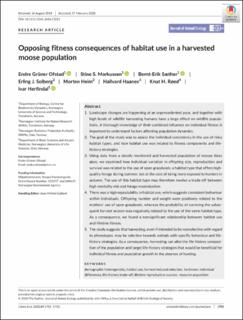| dc.contributor.author | Ofstad, Endre Grüner | |
| dc.contributor.author | Markussen, Stine Svalheim | |
| dc.contributor.author | Sæther, Bernt-Erik | |
| dc.contributor.author | Solberg, Erling Johan | |
| dc.contributor.author | Heim, Morten | |
| dc.contributor.author | Haanes, Hallvard | |
| dc.contributor.author | Røed, Knut | |
| dc.contributor.author | Herfindal, Ivar | |
| dc.date.accessioned | 2020-12-02T09:14:39Z | |
| dc.date.available | 2020-12-02T09:14:39Z | |
| dc.date.created | 2020-05-13T20:52:09Z | |
| dc.date.issued | 2020 | |
| dc.identifier.citation | Journal of Animal Ecology. 2020, 89 (7), 1701-1710. | en_US |
| dc.identifier.issn | 0021-8790 | |
| dc.identifier.uri | https://hdl.handle.net/11250/2711355 | |
| dc.description.abstract | 1. Landscape changes are happening at an unprecedented pace, and together with high levels of wildlife harvesting humans have a large effect on wildlife populations. A thorough knowledge of their combined influence on individual fitness is important to understand factors affecting population dynamics.
2. The goal of the study was to assess the individual consistency in the use of risky habitat types, and how habitat use was related to fitness components and life‐history strategies.
3. Using data from a closely monitored and harvested population of moose Alces alces, we examined how individual variation in offspring size, reproduction and survival was related to the use of open grasslands; a habitat type that offers high‐quality forage during summer, but at the cost of being more exposed to hunters in autumn. The use of this habitat type may therefore involve a trade‐off between high mortality risk and forage maximization.
4. There was a high repeatability in habitat use, which suggests consistent behaviour within individuals. Offspring number and weight were positively related to the mothers' use of open grasslands, whereas the probability of surviving the subsequent harvest season was negatively related to the use of the same habitat type. As a consequence, we found a nonsignificant relationship between habitat use and lifetime fitness.
5. The study suggests that harvesting, even if intended to be nonselective with regard to phenotypes, may be selective towards animals with specific behaviour and life‐history strategies. As a consequence, harvesting can alter the life‐history composition of the population and target life‐history strategies that would be beneficial for individual fitness and population growth in the absence of hunting. | en_US |
| dc.language.iso | eng | en_US |
| dc.publisher | Wiley | en_US |
| dc.rights | Navngivelse 4.0 Internasjonal | * |
| dc.rights.uri | http://creativecommons.org/licenses/by/4.0/deed.no | * |
| dc.title | Opposing fitness consequences of habitat use in a harvested moose population | en_US |
| dc.type | Peer reviewed | en_US |
| dc.type | Journal article | en_US |
| dc.description.version | publishedVersion | en_US |
| dc.source.pagenumber | 1701-1710 | en_US |
| dc.source.volume | 89 | en_US |
| dc.source.journal | Journal of Animal Ecology | en_US |
| dc.source.issue | 7 | en_US |
| dc.identifier.doi | 10.1111/1365-2656.13221 | |
| dc.identifier.cristin | 1810884 | |
| dc.relation.project | Norges forskningsråd: 223257 | en_US |
| dc.relation.project | Norges forskningsråd: 244647 | en_US |
| dc.description.localcode | © 2020 The Author. Journal of Animal Ecology published by John Wiley & Sons Ltd on behalf of British Ecological Society This is an open access article under the terms of the Creative Commons Attribution License, which permits use, distribution and reproduction in any medium, provided the original work is properly cited. | en_US |
| cristin.ispublished | true | |
| cristin.fulltext | original | |
| cristin.qualitycode | 2 | |

